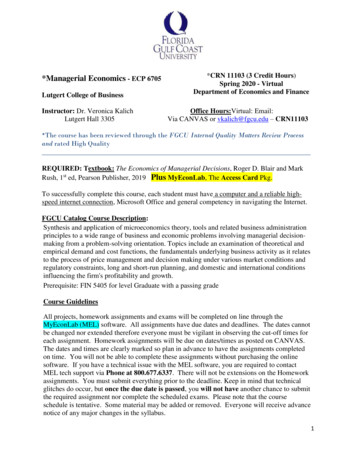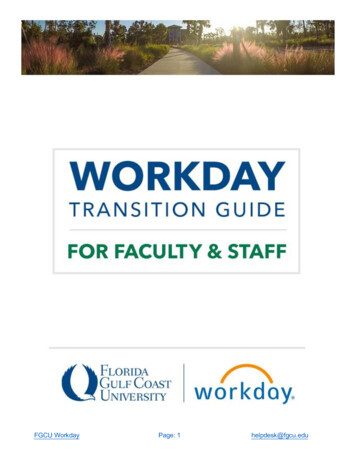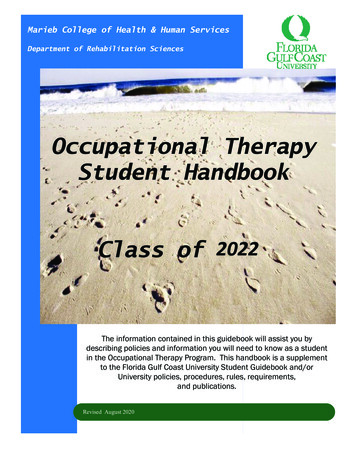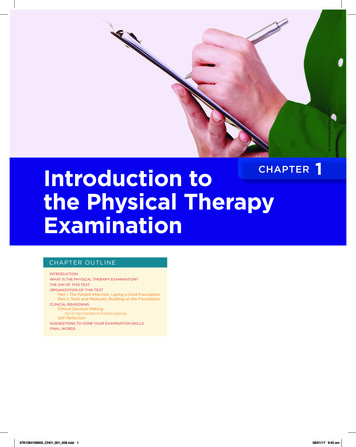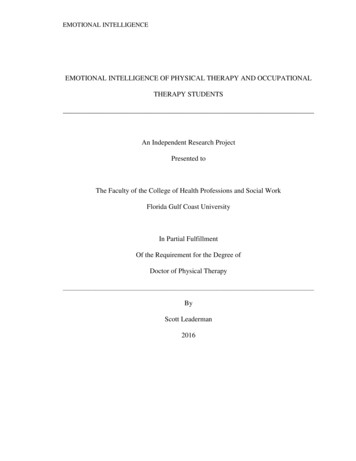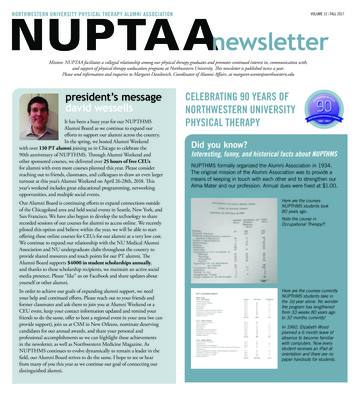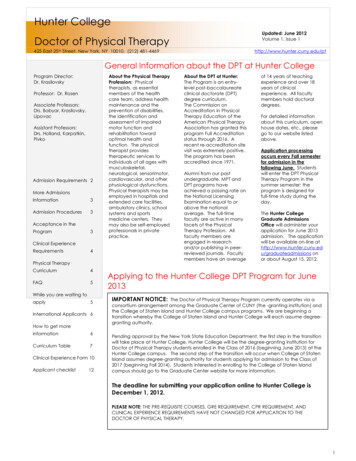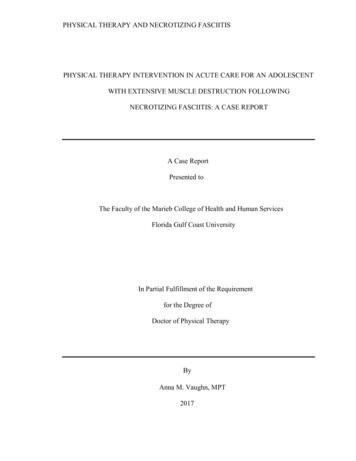
Transcription
PHYSICAL THERAPY AND NECROTIZING FASCIITISPHYSICAL THERAPY INTERVENTION IN ACUTE CARE FOR AN ADOLESCENTWITH EXTENSIVE MUSCLE DESTRUCTION FOLLOWINGNECROTIZING FASCIITIS: A CASE REPORTA Case ReportPresented toThe Faculty of the Marieb College of Health and Human ServicesFlorida Gulf Coast UniversityIn Partial Fulfillment of the Requirementfor the Degree ofDoctor of Physical TherapyByAnna M. Vaughn, MPT2017
PHYSICAL THERAPY AND NECROTIZING FASCIITISAPPROVAL SHEETThis Case Report is submitted in partialfulfillment of the requirements forthe degree ofDoctor of Physical TherapyAnna M. Vaughn, MPTApproved: December 2017Ellen Donald, PhD, PTCommittee ChairpersonThe final copy of this case report has been examined by the signatories, and we find that both the content and theform meet acceptable presentation standards of scholarly work in the above mentioned discipline.
PHYSICAL THERAPY AND NECROTIZING FASCIITISAcknowledgementsI would like to thank several people for assisting in the development andcompletion of this scholarly paper. Firstly, I would like to thank Dr. Ellen Donald for herhelping me narrow the focus of my Case Report and assisting with finalizing this paper.Also, I would like to thank Dr. Alex Rottgers for providing the photographs for thispaper. A special thank you goes to my coworker Janet Willoughby for her unwaveringsupport in treating this patient and for assisting me in completing this paper. To myfamily and friends, thank you for supporting me throughout the last year and half andwhile finishing this paper. Lastly, the greatest appreciation and thanks goes to JamesForsman for always being there for me and for putting up with me as I undertook thisjourney. I cannot thank you enough for your kindness and support I needed to achievethis accomplishment!
PHYSICAL THERAPY AND NECROTIZING FASCIITIS1Table of ContentsAbstract 2Background and Purpose .4Case Description . 6Past Medical and Social History . 6Initial Presentation . 6Identification of NF and Surgical Interventions 7Initiation of Physical Therapy 10Clinical Impression #1 11Physical Therapy Examination .11Clinical Impression #2 12Intervention 12Interdisciplinary Team .18Outcomes .19Post-Discharge .21Discussion .22Conclusion .24References .26
PHYSICAL THERAPY AND NECROTIZING FASCIITIS2AbstractBackground and Purpose: Necrotizing fasciitis (NF) is a rare flesh-eatingbacterium that causes rapid necrosis of soft tissue and fascia. Recent literature has shownthe importance of abdominal muscles in biomechanical body movements. The purpose ofthis case report is to describe the importance of coordinated care amongst multipledisciplines in the development of a novel and effective intervention for physical therapyfor a patient with extensive muscle destruction from NF.Case Description: The patient was a 16-year-old boy admitted to the pediatricintensive care unit with NF of the abdomen and Fournier’s gangrene, who underwentfrequent debridement, muscle flaps, and split-thickness skin graft (STSG).Intervention: Physical therapy was initiated on the first day of his hospital stayand was found to have decreased bilateral ankle dorsiflexion (DF) and positioning needs.Initial physical therapy interventions included passive range of motion (PROM), adaptivepositioning techniques, and family education. As David’s medical condition improved,physical therapy interventions advanced to: active-assist range of motion (AAROM),active range of motion (AROM), transfer training, strengthening, postural training, andgait training with adaptations made for massive muscle destruction of the abdomen andperineum.Outcomes: Prior to physical therapy intervention, David was dependent for allfunctional mobility and displayed significant ROM deficits. He discharged home withclose supervision from family, independent with bed mobility and transfers, andambulating 150 feet with a rolling walker (RW).
PHYSICAL THERAPY AND NECROTIZING FASCIITIS3Discussion: This case report describes the massive muscle destruction caused byNF of the abdomen and perineum, and outlines the physical therapy interventions utilizedto optimize David’s functional mobility. Further research is needed to examine the longterm emotional and physical outcomes of patients with NF.
PHYSICAL THERAPY AND NECROTIZING FASCIITIS4Background and PurposeNecrotizing fasciitis (NF) is a rare flesh-eating bacterium that causes rapidnecrosis of soft tissue and fascia (Vayvada, Demirdover, Menderes, & Karaca, 2013).The incidence of NF is 0.4 cases per 100,000 (Trent & Kirsner, 2002). If not identifiedquickly and managed properly, it is frequently fatal. When NF involves the externalgenitalia and perineum, it is referred to as Fournier’s gangrene (Endorf, Supple, &Gamelli, 2005). Management of Fournier’s gangrene is difficult secondary to frequentcontamination with bowel and urine (Vranckx & D’Hoore, 2012). Aggressive, repetitivedebridement is essential to stop the progression of NF. Amputation is frequently a formof treatment for NF of an extremity but is not an option when it affects the central parts ofthe body. Thus, patients with NF of the trunk and perineal regions have a higher mortalityrate than patients with NF of the extremities (Carter & Banwell, 2004).Literature on the reconstruction of the perineum and abdominal wall in patientswith NF discusses the importance of abdominal muscles in biomechanical bodymovements such as walking, bending, climbing, and posture (Vranckx & D’Hoore,2012). Abdominal muscles also aide in visceral functions of digestion, micturition,defecation, respiration, and expectoration (Vranckx & D’Hoore, 2012). Without optimalsupport of the abdominal muscles, a patient is unable to independently completeeveryday functional tasks.Destruction of major muscle groups is a commonality in both third-degree burnsand NF. Treatment for both injuries typically includes multiple skin grafts and muscletransfers, which can cause joint contractures and scarring. Distortion of skin and muscleincreases a patient’s risk of functional loss as well as psychological problems (Deng et
PHYSICAL THERAPY AND NECROTIZING FASCIITIS5al., 2016). Loss of functional skills can be compounded by: severe weakness, impairedmotor control, decreased cognitive status, pain, risk of graft shearing, and psychologicalfactors such as anxiety and the fear of falling (Trees, Ketelsen, & Hobbs, 2003).Increasing evidence has shown that early rehabilitation strongly improvesphysical function (Burtin et al. 2009; Schweickert et al. 2009), thwarts complicationssuch as intensive care unit (ICU) acquired weakness (Kayambu, Boots, & Paratz, 2015;Kress 2009), and reduces the occurrence of psychological symptoms (Jones et al. 2003)in critically ill patients. Deng et al. (2016) completed a retrospective cohort studyassessing the effects of mobility training on severe burn patients in their Burn IntensiveCare Unit (BICU). Mobility training included: active range of motion (AROM) exercises,transfer training, tilt table training, and progressive ambulation. They concluded thatmobility training was effective in achieving better outcomes than passive training forsevere burn patients.Research reporting effective interventions for patients with severe burns can helpinform practice for those with NF. However, current literature does not provide sufficientdata focused specifically on NF of the central parts of the body. Thus, there is limitedliterature related to physical therapy interventions for patients with NF. The purpose ofthis case report is to describe the importance of coordinated care amongst multipledisciplines in the development of a novel and effective intervention for physical therapyfor a patient with extensive muscle destruction from NF.
PHYSICAL THERAPY AND NECROTIZING FASCIITIS6Case DescriptionPast Medical and Social HistoryFor the purpose of this case report, the patient will be given the factitious name ofDavid. David was a previously healthy 16-year-old boy with a past medical history ofattention deficit hyperactivity disorder (ADHD) and bipolar disorder which was beingtreated with Abilify. His social history included: mother and step-father, five siblingswith four still living in the home, and multiple cats and dogs in the home. David admittedto smoking cigarettes, smoking marijuana, and recent intermittent use of syntheticmarijuana (Spice). He had undergone court order drug screens secondary to a previousencounter with law enforcement for vandalism. David had multiple school suspensionsbut was doing better once he made the school football team. According to David’sparents, he was a highly regarded football player, basketball player, and wrestler for hishigh school.Initial PresentationDavid presented to a small community hospital after a week and a half of chills,generalized weakness, lethargy, scrotal swelling, pain with breathing, abdominal pain,nausea, vomiting, and testicular pain. He delayed medical care secondary to attributingthe abdominal pain from possible withdrawal from Spice and the testicular pain fromgetting kicked in the left groin area during wrestling practice.Due to David’s critical status and suspected septic shock, he was flown to a largerhospital for higher management of care. He underwent an emergent laparoscopicappendectomy secondary to perforated appendicitis with significant diffuse peritonitis.David’s medical status stabilized, and he began to return to his prior level of function.
PHYSICAL THERAPY AND NECROTIZING FASCIITIS7However, six days after the appendectomy David became lethargic, tachycardic, andtachypneic.Identification of NF and Surgical InterventionsDavid underwent emergent exploratory surgery where NF of the abdomen, flank,and inguinal regions was found. Surgical intervention included extensive debridement ofthe scrotum as well as the abdomen and flank. Due to the extent of debridement, threewound vacuum assisted closures (VACs) were placed and he remained intubated aftersurgery. The following day David had a 106 rectal temperature and was suffering fromacute kidney injury. Thus, he was transferred to a free standing pediatric hospitalequipped with urologists and nephrologists.At the pediatric hospital, David continued to be intubated and on theneuromuscular blockade Rocuronium. The following morning it was determined that theNF of the abdomen and flank had progressed to Fournier’s gangrene. David underwentwidespread debridement that included the removal of fascia as well as entire muscles.The muscles removed were: right external obliques, right serratus anterior, and rightinferior latissimus dorsi. Debridement extended from the right axilla down to one-third ofthe right upper leg, where the liver and colon were exposed, and from the left flank to theleft inguinal region (Figure 1). The femoral vessels were protected, and the testes wereexposed but tucked into the thigh pocket/inguinal canal for preservation. Three woundVACs (68x15 cm to right flank, 30x8 cm to right thigh and 30x8 cm to leftflank/scrotum) were placed to optimize healing and vascularization to the areas. Davidexperienced extensive blood loss and required bedside ligation of bleeding arteries aswell as constant blood products.
PHYSICAL THERAPY AND NECROTIZING FASCIITIS8Figure 1. Debridement of right flank and perineum with exposure of liver, colon, andtestes.Over the next four days, David returned to the operating room three times fortherapeutic bronchoscopies as well as re-debridement of all areas to attain healthybleeding tissue. A small abscess was drained and a right chest tube placed secondary to alarge pleural effusion. After a week of hospitalization at the pediatric hospital, Davidunderwent stage one of abdominal wall reconstruction by the plastic surgery group. A20x20 piece of strattice dermal matrix was placed over the large abdominal wound.David underwent additional debridement two times, multiple wound VAC changes, andextubation during the next five days. Two days later he underwent stage two ofabdominal wall reconstruction via abdominal strattice mesh and rotation flap of rightgracilis muscle to perineum (Figure 2). Five days later, his right vastus lateralis musclewas rotated superiorly to assist in closing part of the right trunk defect (Figure 3). Threedays later, David underwent another stage of abdominal wall reconstruction that includedthe placement of 700 square cm of cadaver skin. During that surgery, it was determined
PHYSICAL THERAPY AND NECROTIZING FASCIITIS9that he had multiple abscesses, poor healing of previous right lateral thorax incision, anda large seroma. A week later, 32 ml of purulent fluid was removed from the right pleuralcavity. Three days later, David suffered from bilateral enterocutaneous fistulae. Luckilywith the cessation of nasogastric (NG) feeds, the fistula resolved without surgicalintervention. David’s abdominal wound was closed ten days later via STSG from his leftleg. Throughout all his surgeries, he was on various degrees of bedrest and activityrestriction.Figure 2. Right gracilis muscle flap to perineum.
PHYSICAL THERAPY AND NECROTIZING FASCIITIS10Figure 3. Right vastus lateralis muscle rotated superiorly to close flank.Initiation of Physical TherapyPhysical therapy was consulted on David’s first day of admission to the pediatrichospital for possible splint placement. He was critically ill, intubated, and medicallyparalyzed. David displayed global edema and passive neutral ankle DF bilaterally. Due tohis expected prolonged intubation and immobility, he was provided bilateral prefabricated resting AFOs to maintain ankle ROM and optimize joint integrity needed forweight-bearing activities. Physical therapy assisted the bedside nurse in positioning thepatient in a manner that would minimize global edema as well as offload the ischialtuberosities for optimal healing of the acquired sacral pressure injury. David’s parentswere visibly distraught but insisted on actively helping in the patient’s recovery. Physicaltherapy educated David’s parents on proper donning and doffing of the resting AFOs,positioning techniques, and PROM of David’s extremities. David’s initial physicaltherapy frequency was 2x/week to minimize his risk of joint contractures as well asreduce his risk of further skin breakdown.
PHYSICAL THERAPY AND NECROTIZING FASCIITIS11Clinical Impression #1Due to the complex medical/surgical history, severity of his present condition,and varying degrees of activity restriction, David was at an increased risk of additionalpressure injuries, joint contractures, and ICU acquired weakness. He was a goodcandidate for initiating a physical therapy examination and intervention because of hisacquired sacral pressure injury, extensive muscle destruction requiring STSG, muscleflaps, and movement precautions set forward by the surgeons.Physical Therapy ExaminationA more extensive examination was performed two weeks after David’s firstphysical therapy evaluation. At that time, he was status post stage one and stage two ofabdominal wall reconstruction as well as right gracilis muscle flap to the perineum.Plastic surgery allowed active and passive ROM to David’s tolerance. David wasextubated but on 30L of Vapotherm; thus, still difficult for him to communicate his needsand wants. David’s overall ROM and mobility were limited by the placement of a rightchest tube to wall suction, two large abdominal wound VACs to suction, and two JacksonPratt (JP) drains.The examination revealed: significant abdominal pain, decreased bed mobility,decreased AAROM, decreased activity tolerance, and decreased strength. David requiredmoderate assistance to roll supine to left side-lying and maximum assistance to rollsupine to right side-lying. Right lower extremity (LE) AAROM was substantial for: 40 knee flexion, 10 straight-leg raise (SLR), and 20 of hip internal rotation (IR). Left LEAAROM was noteworthy for: 70 of knee flexion and 30 of SLR. David lacked 20 offull right neck rotation. AROM of bilateral ankles to neutral ankle DF. With his head of
PHYSICAL THERAPY AND NECROTIZING FASCIITIS12bed (HOB) elevated to 45 , he lifted his back 30 off the bed with hand-held assist timestwo. David required frequent rest breaks due to poor breath support. Strength was notformally assessed due to the absence of muscles, pain with tactile stimuli, and inability tomove his LEs without assistance. Transfers were not assessed secondary to his pain andthe limitations of his medical equipment.Clinical Impression #2Prior to this hospitalization, David had fully intact muscles, was independent withall functional mobility, and was a multi-sport high school athlete. On examination in thehospital, the patient was found to have permanent, extensive muscle destruction whichresulted in prolonged dependency of respiratory support, global pain, decreased AAROMof LEs, generalized weakness, postural abnormalities, and significant decline infunctional mobility. Early initiation of physical therapy to facilitate a “new way” tocomplete functional tasks without major muscle groups was necessary.InterventionDue to the David’s medical condition changing day-to-day, every therapy sessionbegan with communication with the surgeons and/or nursing staff as well as examinationof his current functional status. Daily examination included but was not limited to: pain,alertness, ROM, strength, positional needs, activity tolerance, functional mobility, andfamily education. The intervention was deemed effective if “old” goals were met and“new” goals were established. The ultimate outcome was for David to live as normal of alife as possible, despite significant scarring from widespread muscle destruction causedby NF.
PHYSICAL THERAPY AND NECROTIZING FASCIITIS13After the physical therapy examination, David’s frequency was increased to6x/week. Therapy sessions focused on bed level activities that included: modifiedcrunches, bilateral LE strengthening exercises, stretching of bilateral hamstrings andgastrocnemius muscles, AROM of neck in all positions, and education on a homeexercise program (HEP). The HEP included ankle pumps, straight leg raise (SLR), heelslides, and bilateral hip IR/ER.Over the next week, David underwent right vastus lateralis muscle flap to hisabdomen to provide visceral support and instructed to avoid “crunches.” To optimize hishemodynamics and to introduce gentle LE weight-bearing activities, a tilt table wasutilized in treatment sessions. The incline of the tilt table was gradually increased tofacilitate tolerance to a more upright position. Full upright on the tilt table was neverachieved secondary to 6/10 right LE pain.David underwent placement of allograft skin to his abdomen in prep for STSG.The plastic surgeon approved out of bed (OOB) activities if there was no friction, torsion,or touching of the right flank area. David was dependently lifted into a cardiac chair toavoid any shearing forces. His functional mobility was limited that week due to 7/10stomach pain and emotional instability secondary to his family not being at bedside. Toimprove his mental state, physical therapy coordinated with nursing staff to allow him togo outside. An egg-crate was placed in the cardiac chair to offload his ischial tuberositiesto optimize comfort and to allow healing of his previously acquired sacral pressureinjury. David displayed decreased tolerance to his legs in the dependent positionsecondary to increased stretch on the right hip flexors.
PHYSICAL THERAPY A
physical therapy interventions advanced to: active-assist range of motion (AAROM), active range of motion (AROM), transfer training, strengthening, postural training, and gait training with adaptations made for massive muscle destruction of the abdomen and perineum. Outcomes: Prior to p
